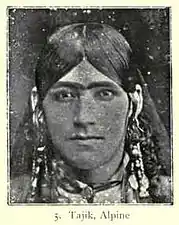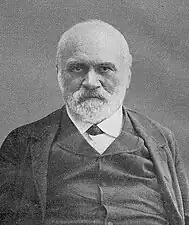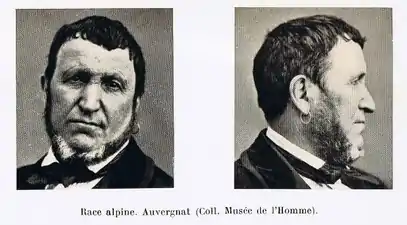
The Alpine race is a historical race concept defined by some late 19th-century and early 20th-century anthropologists as one of the sub-races of the Caucasian race.[1][2][3] The origin of the Alpine race was variously identified. Ripley argued that it migrated from Central Asia during the Neolithic revolution, splitting the Nordic and Mediterranean populations. It was also identified as descending from the Celts residing in Central Europe in Neolithic times.[4] The Alpine race is supposedly distinguished by its moderate stature, neotenous features, and cranial measurements, such as high cephalic index.[5]
History
The term "Alpine" (H. Alpinus) has historically been given to denote a physical type within the Caucasian race, first defined by William Z. Ripley (1899), but originally proposed by Vacher de Lapouge. It is equivalent to Joseph Deniker's "Occidental" or "Cevenole" race,[6][7] while Jan Czekanowski regarded it as a subrace consisting of a mixture of Nordic and Armenoid. In the early 20th century, the Alpine physical type was popularised by numerous anthropologists, such as Thomas Griffith Taylor and Madison Grant, as well as in Soviet era anthropology.[8][9]
The German Nazi Party under the influence direction of Hans F. K. Günther, recognized the Germans as including five racial subtypes, described by Günther in his work Kleine Rassenkunde des deutschen Volkes (1929): Nordic, Alpine, Mediterranean, East Baltic, and Dinaric, viewing Nordics as being at the top of the racial hierarchy.[1] He defined each racial subtype according to general physical appearance and their psychological qualities including their "racial soul"—referring to their emotional traits and religious beliefs, and provided detailed information on their hair, eye, and skin colours, facial structure, and body types.[1] He provided photographs of Germans identified as Nordic in places like Baden, Stuttgart, Salzburg, and Swabia; and provided photographs of Germans he identified as Nordic and Mediterranean types, especially in Bavaria and the Black Forest region of Baden.[1] He also noted that the Alpine races in France spread fast after the French Revolution and Napoleonic War.[10] Hitler was so impressed by this work by Günther, that he made it the basis of his eugenics policy.[1]
Adolf Hitler utilized the term Alpine to refer to a type of the Aryan race, and in an interview spoke admiringly about his idol Italian Fascist leader Benito Mussolini, commending Mussolini's Alpine racial heritage saying:
They know that Benito Mussolini is constructing a colossal empire which will put the Roman Empire in the shade. We shall put up [...] for his victories. Mussolini is a typical representative of our Alpine race
— Adolf Hitler, 1931[11]
It however fell out of popularity by the 1950s, but reappeared in the literature of Sonia Mary Cole (1963) and Carleton Coon (1969).[12] In more recent sources, a small array of anthropologists accustomed with such usage, still use the term.[13][14]
Physical appearance
A typical Alpine skull is regarded as brachycephalic ('broad-headed').[15] As well as being broad in the crania, this thickness appears generally elsewhere in the morphology of the Alpine, as Hans Günther describes:
The Alpine race is short-headed and broad-faced. The cephalic index is about 88 on the average, the facial index under 83. In the Alpine race the length of the head is only a little or barely greater than the breadth, owing to the relatively considerable measurement of this latter. The Alpine head may be called round. It juts out only slightly over the nape, and this back part is fairly roomy, so that in the Alpine man only a little of the neck is to be seen above the coat-collar. The cast of countenance gives the effect of dullness, owing to the steeply rising forehead, vaulted backwards, the rather low bridge to the nose, the short, rather flat nose, set clumsily over the upper lip, the unprominent, broad, rounded chin.[16]
 Henry Keane's Man, Past and Present (1899) shows a Tajik as an example of the Alpine type
Henry Keane's Man, Past and Present (1899) shows a Tajik as an example of the Alpine type An Italian from the Piedmont - of the Alpine (Alpinoid) type
An Italian from the Piedmont - of the Alpine (Alpinoid) type An Austrian from the South Tyrol of the Alpine type
An Austrian from the South Tyrol of the Alpine type Meyers Blitz-Lexikon (Leipzig, 1932) shows the German cartographer Heinrich Kiepert as an example of the Alpine type
Meyers Blitz-Lexikon (Leipzig, 1932) shows the German cartographer Heinrich Kiepert as an example of the Alpine type A Frenchman from the Auvergne - of the Alpine (Alpinoid) type
A Frenchman from the Auvergne - of the Alpine (Alpinoid) type
Ripley (1899) further notes that the nose of the Alpine is broader (mesorrhine) while their hair is usually a chestnut colour and their occiputs are slightly rounded. According to Robert Bennett Bean (1932) the skin pigmentation of the Alpine is an 'intermediate white', a colour in-between the lighter skinned Nordic and the darker-skinned Mediterranean.[17] Despite the large numbers of alleged Alpines, the characteristics of the Alpines were not as widely discussed as those of the Nordics and Mediterraneans. Typically they were portrayed as "sedentary": solid peasant stock, the reliable backbone of the European population, but not outstanding for qualities of leadership or creativity. Madison Grant insisted on their "essentially peasant character".[18]
Geography and origin
According to Ripley and Coon, the Alpine race is predominant in Central Europe and parts of Western/Central Asia. Ripley argued that the Alpines had originated in Asia, and had spread westwards along with the emergence and expansion of agriculture, which they established in Europe. By migrating into Central Europe, they had separated the northern and southern branches of the earlier European stock, creating the conditions for the separate evolution of Nordics and Mediterraneans. This model was repeated in Madison Grant's book The Passing of the Great Race (1916), in which the Alpines were portrayed as the most populous of European and western Asian races.
In Carleton Coon's rewrite of Ripley's The Races of Europe, he developed a different argument that they are a reduced Upper Paleolithic survivors indigenous to Europe:[19]
Alpine: A reduced and somewhat foetalized survivor of the Upper Palaeolithic population in Late Pleistocene France, highly brachycephalized; seems to represent in a large measure the bearer of the brachycephalic factor in Crô-Magnon. Close approximations to this type appear also in the Balkans and in the highlands of western and central Asia, suggesting that its ancestral prototype was widespread in Late Pleistocene times. In modern races it sometimes appears in a relatively pure form, sometimes as an element in mixed brachycephalic populations of multiple origin. It may have served in both Pleistocene and modern times as a bearer of the tendency toward brachycephalization into various population.
A debate concerning the origin of the Alpine race in Europe, involving Arthur Keith, John Myres and Alfred Cort Haddon was published by the Royal Geographical Society in 1906.[20]
See also
References
- 1 2 3 4 5 Maxwell, Anne (2010). Picture Imperfect: Photography and Eugenics, 1870–1940. Sussex Academic Press. ISBN 978-1-84519-415-4.
- ↑ Fluehr-Lobban, Carolyn (2005). Race and Racism: An Introduction. Rowman Altamira. pp. 127–133. ISBN 0-7591-0795-5.
- ↑ The Races of Europe by Carleton S. Coon
- ↑ MacCulloch, J. A. (2003). The Religion of the Ancient Celts. Kessinger. p. 8. ISBN 0-486-42765-X.
- ↑ Coon, Carleton (1939). The Races of Europe. Macmillan. pp. 437-438 Plate 11.
- ↑ Deniker, J. (1904). "Les Six Races Composant la Population Actuelle de l'Europe". The Journal of the Anthropological Institute of Great Britain and Ireland (in French). 34: 181–206. doi:10.2307/2843096. JSTOR 2843096.
- ↑ Ripley, William Z. (1899). "Deniker's Classification of the Races of Europe". The Journal of the Anthropological Institute of Great Britain and Ireland. 28 (1/2): 166–173. doi:10.2307/2842946. JSTOR 2842946.
- ↑ Taylor, Griffith (1931). "The Nordic and Alpine Races and Their Kin: A Study of Ethnological Trends". American Journal of Sociology. 37 (1): 67–81. doi:10.1086/215619. S2CID 143811447.
- ↑ "The Great Soviet Encyclopaedia" (in Russian).
- ↑ The Racial Elements of European History by Hans F.K. Günther. Chapter IX Part Three: The Denordization of the Peoples of Romance Speech: "The French Revolution was a very thorough denordization of France. At that time it was often enough to be blond to be dragged to the scaffold. The French Revolution must be read as an Alpine-Mediterranean rising against a noble and burgher upper class of Nordic race. The Alpine race has spread very fast, one might say astoundingly fast, in France in the nineteenth century."
- ↑ Breiting, Richard (1971). Calic, Édouard (ed.). Secret Conversations with Hitler : The Two Newly-Discovered 1931 Interviews. New York: John Day Co. p. 77. OCLC 906949733.
- ↑ Coon, Carleton Stevens; Hunt, Edward E. (1969). The Living Races of Man. New York: Knopf. p. 66. OCLC 490400.
- ↑ Pearson, Roger (1985). Anthropological Glossary. Malabar, FL: Krieger Publishing. ISBN 0-89874-510-1.
- ↑ Brues, Alice Mossie (1990). People and Races. Prospect Heights, IL: Waveland Press. ISBN 0-88133-482-0.
- ↑ The Alpine Races in Europe, John L. Myres, The Geographical Journal, Vol. 28, No. 6 (Dec., 1906), pp. 537-553.
- ↑ Günther, Hans (1927). The Racial Elements of European History. Kennikat Press. pp. 35-36.
- ↑ The Races of Man. Differentiation and Dispersal of Man, p. 32.
- ↑ Grant, Madison, The Passing of the Great Race, 1916, part 2, ch. 11; part 2, chapter 5.
- ↑ Stevens Coon Carleton. (1939). "Chapter VIII. Introduction to the Study of the Living". The Races Of Europe. Osmania University, Digital Library Of India. The Macmillan Company. p. 291.
- ↑ "The Alpine Races in Europe: Discussion, D. G. Hogarth, Arthur Evans, Dr. Haddon, Dr. Shrubsall, Mr. Hudleston, Mr. Gray, Dr. Wright and Mr. Myres", The Geographical Journal, Vol. 28, No. 6 (Dec., 1906) (pp. 553-560).
Further reading
- Spiro, Jonathan P. (2009). Defending the Master Race: Conservation, Eugenics, and the Legacy of Madison Grant. Univ. of Vermont Press. ISBN 978-1-58465-715-6.
